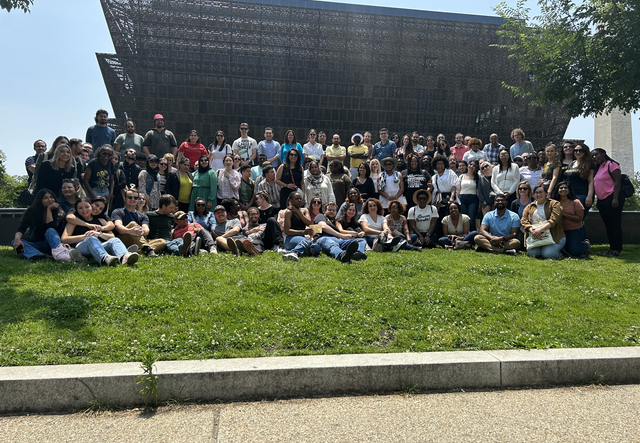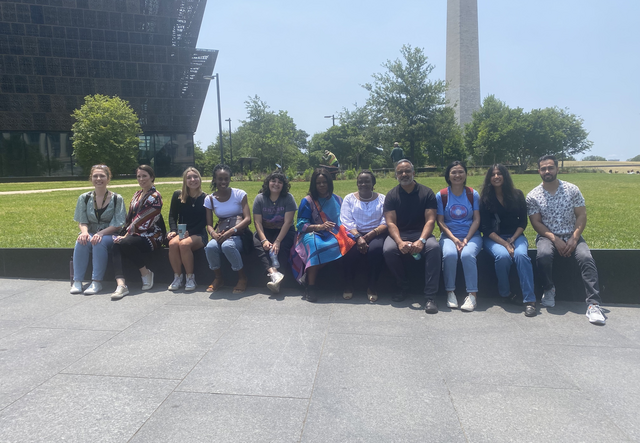The IRC in Silver Spring is committed to ensuring that our work addresses the impacts of oppression and marginalization in order to create a diverse and welcoming environment for local refugees, our partners, volunteers and the broader community.
In honor of Juneteenth, staff from the IRC in Silver Spring and Baltimore visited the African American History & Culture Museum in Washington D.C. to learn, reflect and grow as individuals and an office.
One staff member shared: "It was such an amazing and enriching experience to visit the National Museum of African American History & Culture for the first time. The stories of struggle, triumph and perseverance that were presented were an inspiration and it was extremely valuable to get a chance to understand the greater context in which our work can continue to evolve through a greater focus on a historical-forward approach oriented toward equity."
Below you will find two of our colleague’s experience and reflection of their visit:

Reflection by Artem Kulyk
As a commemoration of Juneteenth, the employees of the IRC offices in Baltimore and Silver Spring visited the National Museum of African American History and Culture. I have been to the museum before but was looking forward to exploring the exhibits in more detail and was especially interested in the influences and contributions that the African Americans have had on music, in particular - Jazz and Rock-n-Roll. However, the visit led me to analyze and think much more about the repercussions of our everyday actions than about Billi Holiday or Miles Davis.
Exploring the displays about the history of slavery, I could not stop thinking of how fortunate I am to be able to never encounter such atrocities. With that being said, the repercussions of slavery, racial prejudice, inequality, stigmas and negative stereotypes is something that continues to have a profound impact on our everyday life.
Many believe, that when we are born, we start from a Tabula Rasa (clean slate) – the epitome of the American Dream - when we can come from nothing to become whatever we want – but is that really so?
In our everyday interactions at work and in life we inadvertently judge people without realizing what they have been through. Being a Ukrainian immigrant, I believe I can at least remotely and partially understand what the Ukrainian refugees are going through because of Russian invasion of Ukraine. However, when speaking with asylum seekers from, for example, Central American countries, I cannot imagine what they had to go through to be where they are. The museums, at times, horrific history of the African Americans struggles throughout centuries has made me realize how as an employee of IRC, but even more as a human being, we should not judge people on their current physical/emotional state, as we have not the slightest idea what they have had to face to be where they are. All we can do is to help - in any capacity that we can.
And if we can find common ground with each other while listening to Miles Davis or Billie Holiday that only makes this world just a little bit of a better place.

Reflection by Timothy Pracher
On Thursday June 15, IRC offices in Baltimore and Silver Spring closed so that all staff could pause for a day to visit the National Museum of African American History and Culture (NMAAHC). As soon as I heard about the staff field trip to NMAAHC, I was grateful that we would have the opportunity to reflect on the intersection between slavery, US immigration, and refugees just a few days before Juneteenth. The trip would be an opportunity to reflect on a question that we don't often discuss explicitly: how does the United States' history of slavery inform our work helping refugees build new lives in the DC area?
I expected to move through the museum while processing information with my colleagues, but the visit turned out to be mostly an individual exploration for me and I was glad to be able to absorb information at my own pace. I learned about some of the nuances that differentiated communities of enslaved people on various parts of the eastern seaboard in the 1700s. My heart continued to break as I read about the events of the next century including the sale of enslaved people, the separation of families, and the capture of people escaping slavery. It was a dark reality check to read on a poster preserved from that era that a larger reward would be paid if escaped slaves were returned to Montgomery County - where I live and work.
One of the reasons I choose to work in the field of refugee resettlement is because I feel a responsibility to help provide others with opportunities that I was afforded without question. While refugee resettlement helps many people in need, one uncomfortable truth continues to be true - this country was built on the backs of people who were exploited and robbed the fruits of their own labor. Equally difficult is the fact that today certain people reap more benefits of that labor than others. In addition, the kidnapping and enslaving of other humans, along with other aspects of colonization, has led to decades and hundreds of years of tumult and disarray in many countries.
As someone who has been dedicated to social justice since an early age, I had been thinking about our visit to the museum as a responsibility; my assignment was to develop a concise explanation for how slavery occurring 150+ years ago is connected to refugees arriving today. But I realized that this question, and our museum visit, could be reframed as an opportunity for deeper personal reflection. Visiting NMAAHC was an opportunity to reflect on history that directly or indirectly led us to the historical moment where we sit today.
Continuing to reflect on the information I absorbed during the visit to NMAAHC has provided an additional layer of complexity to my thoughts on history, power, privilege, conflict, and migration. As a nation (and a global community) we are at a crossroads, an intersection, where we can choose to take responsibility for the atrocities of slavery - or to continue to ignore the historical events which make us most uncomfortable. Beginning a process of reconciliation, the first step on a path towards healing, will require much more reflection on the historical events of the past 500 years.